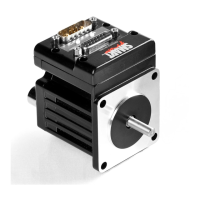Moog Animatics SmartMotor™ Developer's Guide,Rev. L
Page 131 of 909
Commutation Modes
Because the SmartMotor uses a brushless motor, it does not have the mechanical commutator
that a brushed motor has to switch the current to the next optimal coil as the rotor swings
around. To cause shaft rotation in a brushless motor, the control electronics have to see
where the shaft is, and then decide which coils to deliver the current to next.
The most typical way to determine the orientation of the rotor is with small magnetic-sensing
devices called Hall sensors. The process of shifting the current to the proper coils based on
shaft rotation is called commutation. There are many methods for commutating a motor; the
best commutation method depends on the application. As a general rule, sine mode
commutation provides very smooth low torque ripple performance, and trapezoidal
commutation provides the highest torque and fastest speeds.
The following commands allow selection of different commutation modes. For more details,
see Part 2: SmartMotor Command Reference on page 238.
NOTE: MDE, MDS and MDC require angle match (the first sighting of the encoder
index) before they will take effect. This means the SmartMotor's factory calibration
is valid and the index mark of the internal encoder has been seen since startup.
Until then, the SmartMotor will operate in default MDT.
MDT
Mode Drive Trapezoidal
Trapezoidal commutation uses only the Hall sensors (default). It is the most simple
commutation method, and it is always ready on boot up. MDT is effective despite the minor
inaccuracies typically found in the mechanical placement of the sensors.
NOTE: M-style motors boot up in MDC mode (see MDC on page 132).
MDE
Mode Drive Enhanced
This driving method is exactly the same as basic trapezoidal commutation using Hall sensors,
except that it also uses the internal encoder to add accuracy to the commutation trigger
points. This idealized trapezoidal commutation mode offers the greatest motor torque and
speed, but it can exhibit minor ticking sounds at low rates because the current shifts abruptly
from one coil to the next. Because MDE uses the encoder, it requires angle match (the first
sighting of the encoder index) before it will engage.
MDS
Mode Drive Sine
This is sinusoidal (sine) commutation, voltage mode. It provides smoother commutation
compared to trapezoidal modes by shifting current gradually from one coil to the next.
Because MDS uses the encoder, for motors with incremental encoders, it requires angle
match (the first sighting of the encoder index) before it will engage. MDS is not as efficient as
a trap commutation mode and has less torque available, especially at higher speeds (for more
details, see MDS on page 544). However, for applications that require extremely smooth and
quiet low-speed operation, MDS is the best choice.
Part 1: Programming: Commutation Modes

